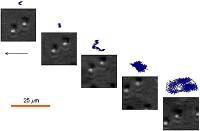Jan 24 2008
Blood coursing through vessels, lubricated cartilage sliding against joints, ink jets splashing on paper - living and nonliving things abound with fluids meeting solids. However important these liquid/solid boundaries may be, conventional methods cannot measure basic mechanical properties of these interfaces in their natural environments. Now, researchers at the National Institute of Standards and Technology (NIST) and the University of Minnesota have demonstrated a video method that eventually may be able to make measurements on these types of biological and industrial systems.
 Microscopic beads embedded in a gel surface were used to trace the motion of a gel forming an interface with a liquid. As the gel/liquid interface was stirred, the beads followed a complicated trajectory (patterns above photos), which the researchers broke down into a range of small, fast movements to large, slow movements in order to determine the gel's underlying mechanical properties. As the strength of the flow is increased (from left to right), the scale of the motion increases.
Microscopic beads embedded in a gel surface were used to trace the motion of a gel forming an interface with a liquid. As the gel/liquid interface was stirred, the beads followed a complicated trajectory (patterns above photos), which the researchers broke down into a range of small, fast movements to large, slow movements in order to determine the gel's underlying mechanical properties. As the strength of the flow is increased (from left to right), the scale of the motion increases.
Optical microrheology - an emerging tool for studying flow in small samples - usually relies on heat to stir up motion. Analyzing this heat-induced movement can provide the information needed to determine important mechanical properties of fluids and the interfaces that fluids form with other materials. However, when strong flows overwhelm heat-based motion, this method isn't applicable.
Motivated by this, researchers developed a video method that can extract optically basic properties of the liquid/solid interface in strong flows. The solid material they chose was a gel, a substance that has both solid-like properties such as elasticity and liquid-like properties such as viscosity (resistance to flow).
In between a pair of centimeter-scale circular plates, the researchers deposited a gel of polydimethylsiloxane (a common material used in contact lenses and microfluidics devices). Pouring a liquid solution of polypropylene glycol on the gel, they then rotated the top plate to create forces at the liquid/gel interface. The results could be observed by tracking the motion of styrene beads in the gel.
The researchers discovered that the boundary between the liquid and gel became unstable in response to “mechanical noise” (irregularities in the motion of the plates). Such “noise” occurs in real-world physical systems. Surprisingly, a small amount of this mechanical noise produced a lot of motion at the fluid/gel interface. This motion provided so much useful information that the researchers could determine the gel’s mechanical properties - namely its “viscoelasticity” - at the liquid/gel interface.
The encouraging results from this model system show that this new approach could potentially be applied to determining properties of many useful and important liquid/solid interfaces. The NIST/Minnesota approach has possible applications in areas as diverse as speech therapy where observing the flow of air over vocal cords could enable noninvasive measures of vocal tissue elasticity and help clinicians detect problems at an early stage. Also, this research may help clarify specific plastics manufacturing problems, such as “shear banding,” in which flow can separate a uniformly blended polymer undesirably into different components.